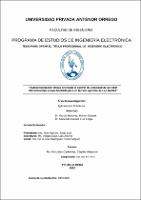Autosintonización difusa orientada al control de velocidad de un robot diferencial tipo oruga diseñado para un terreno agrícola de La Libertad

View/
Download
(application/pdf: 19.86Mb)
(application/pdf: 19.86Mb)
Date
2022Author(s)
García Honores, Marlon Gabriel
Moncada Calmet, Luis Felipe
Metadata
Show full item recordAbstract
El presente trabajo de investigación consistió en la evaluación de controles de velocidad autosintonizados por lógica difusa correspondientes a diferentes números de zonas de difusificación y desdifusificación en su sistema difuso, implementados en un robot móvil diferencial tipo oruga y desempeñado en un terreno agrícola a diferentes velocidades. Todo esto, con el objetivo de determinar las características en el dominio del tiempo para cada sistema de autosintonización a diferentes velocidades en terrenos agrícolas; los cuales, suelen ser de difícil acceso para robots no diseñados en condiciones de irregularidad en su trayectoria. El trabajo inició con el sustento del uso de los controladores autosintonizables basados en lógica difusa. Se mencionó que la mayoría de las plantas en el mundo real son no lineales y variantes en el tiempo, por lo tanto, para su accionamiento por medio del control clásico estas deben ser linealizadas, perdiendo de esa manera precisión en el control. Así mismo, se presentó el estado del arte donde se proporcionó toda la teoría en relación a la cinemática del robot diferencial, control discreto, lógica difusa y la autosintonización de ganancias de control. El trabajo continuó con la implementación de algoritmos con diferentes números de zonas de difusificación y desdifusificación para el controlador difuso autosintonizado y teniendo en cuenta la erradicación de desviaciones, se explicó el método y características de diseño para el controlador, siguiendo un protocolo que permitió comparar su desempeño de manera equitativa para cada número de zonas. Posteriormente, los controladores se sometieron a un suelo agrícola, donde se documentó el proceso y se extrajeron las características en el dominio del tiempo correspondiente a la variable de proceso de cada motor del robot; tales como, el tiempo de asentamiento, tiempo de subida, tiempo pico, tiempo de retardo, el porcentaje de sobrepaso máximo y el error estacionario, con el motivo de realizar el análisis de cada sistema difuso y su comparación. Finalmente, el trabajo concluyó con la presentación de los controladores más idóneos correspondientes a determinadas características en dominio del tiempo que representan estabilidad, exactitud y rápidez junto con desviación promedio. The present research work consisted in the evaluation of self-tuned speed controls by fuzzy logic corresponding to different numbers of diffusification and defuzzification zones in its fuzzy system, implemented in a caterpillar-type differential mobile robot and performed in an agricultural field at different speeds. All this, in order to determine the characteristics in the time domain for each self-tuning system at different speeds in agricultural land; which are usually difficult to access for robots not designed in conditions of irregularity in their trajectory. The work started with the support of the use of self-tuning controllers based on fuzzy logic. It was mentioned that most of the plants in the real world are non-linear and variant in time, therefore, for their activation by means of classical control, they must be linearized, thus losing precision in the control. Likewise, the state of the art was presented where all the theory was presented in relation to the differential robot kinematics, discrete control, fuzzy logic and control gain auto-tuning. The work continued with the implementation of algorithms with different numbers of diffusion and defuzzification zones for the self-tuned fuzzy controller and taking into account the eradication of deviations, the design method and characteristics for the controller were explained, following a protocol that helped to compare their performance equally for each number of zones. Subsequently, the controllers were subjected to an agricultural soil, where the process was documented and the characteristics in the time domain corresponding to the process variable of each robot motor were extracted; such as the settling time, rise time, peak time, delay time, the percentage of maximum overshoot and the stationary error, with the purpose of performing the analysis of each fuzzy system and its comparison. Finally, the work concluded with the presentation of the most suitable controllers corresponding to certain characteristics in the time domain that represent stability, accuracy, speed and average deviation.
Collections
- Ingeniería Electrónica [146]

